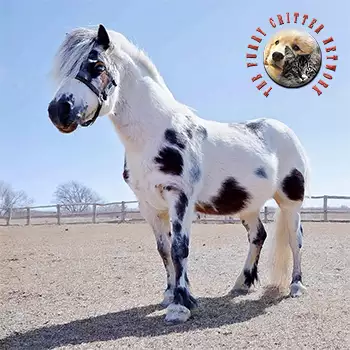General Description
Pony of the Americas should show style and substance, beauty and symmetry, being a balanced individual regardless of size and correct in all aspects of conformation, exhibiting approved color patterns and characteristics. The POA is between 46 and 56 inches in height at maturity. The symmetrical and smooth head is clean cut and slightly dished, showing mottled skin about the nostrils and lips; forehead is wide; sclera of eyes is white, adding distinctiveness to head appearance. The neck shows quality with clean cut throat latch and large windpipe; chest is deep and blends into well-muscled sloping shoulders; withers are prominent and well-defined; forearm is well muscled, long, wide and tapered down to a broad knee; cannons are short, wide and flat with wide, smooth and strongly supported fetlocks; pastern is medium long and sloping; hooves are striped, rounded, deep, open and wide at heels; back is short and straight; loin is short and wide; underline is long with the flank well let down; hips are smoothly covered, being long, sloping and muscular; thighs are long, muscular and deep, blending into well-rounded quarters; gaskins are long, wide and muscular, extending to clean, clearly defined, wide, straight hocks.
Quality of a POA: Quality refers to substance, style and refinement. The ponies should be well proportioned, the skin soft and pliable, in good health and flesh (not too fat or too thin), with the overall appearance of refinement, style, beauty and substance.
Head and Neck: Showing style and character, the neck should be slightly arched and clean cut, with a distinctly defined throat latch. The head should be proportionate in size to the body, with clean cut features. The eyes should be large, kind and prominent. The ears should be medium in size, pointedly alert and well carried.
Hindquarters: The croup should be long, level and muscular; the quarters and gaskins, deep and muscular. The hocks should be clean cut and well supporting.
Body: The body should be round, full ribbed, heavily muscled, with well-sprung ribs; back and loin short, wide and well muscled, with a long underline.Feet and Legs: The feet should be proportionate to the size of the pony, of good shape, wide and deep at the heels. The legs should be in correct position front, side and rear view; the pasterns a medium 45 degree angle. The cannons should be lean and flat; the knees broad, tapering gradually into cannon. The arm and forearm should show muscle; the chest should be fairly wide, deep and full. The shoulders should be deep and well laid in, sloping 45 degrees. The withers should be prominent with good saddle base. The legs should be set squarely under the body, straight and true at each comer so that the animal is well-balanced and travels easily. The hocks should be clean-cut, and well supporting. Cannons should be lean and flat; knees broad, tapering gradually into cannon. The ankles should be firm, the sloping pasterns medium length and the fetlocks clean of excess hair.
Chest: The chest should be fairly wide, deep and full; shoulders deep and well laid in, sloping 45 degrees. The withers should be prominent with good saddle base.
Gaits of a POA: This refers to a way of going. Walk - straight with long, easy stride, true and flat footed. The western jog trot should be soft, relaxed, and quiet with a definite two beat gait. At no time should it resemble a running walk nor should it be rough or stilted. The speed and stride should be compatible with the pony size. The English trot should be a free-moving, ground covering stride, executed in a long, low frame. Excessive knee or hock action is at no time desirable. Quick, short strides should be penalized. The lope or canter should be rolling and comfortable with b emphasis on a natural three beat, soft lope. A four beat lope is at no time desirable and should be penalized.






